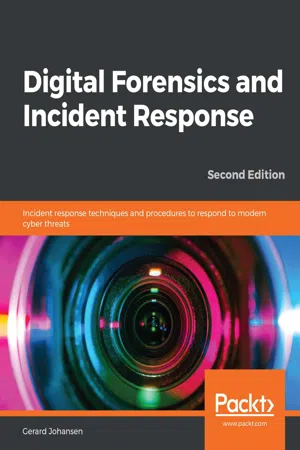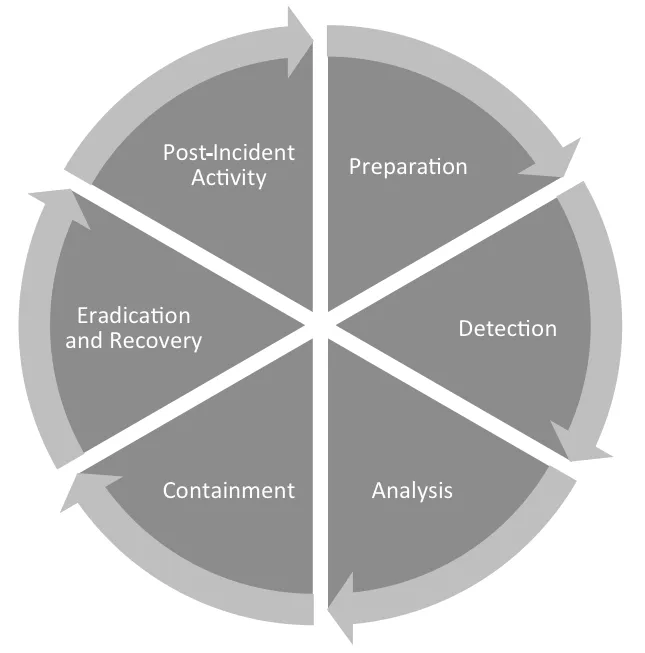
Digital Forensics and Incident Response
Incident response techniques and procedures to respond to modern cyber threats, 2nd Edition
Gerard Johansen
- 448 pages
- English
- ePUB (mobile friendly)
- Available on iOS & Android
Digital Forensics and Incident Response
Incident response techniques and procedures to respond to modern cyber threats, 2nd Edition
Gerard Johansen
About This Book
Build your organization's cyber defense system by effectively implementing digital forensics and incident management techniques
Key Features
- Create a solid incident response framework and manage cyber incidents effectively
- Perform malware analysis for effective incident response
- Explore real-life scenarios that effectively use threat intelligence and modeling techniques
Book Description
An understanding of how digital forensics integrates with the overall response to cybersecurity incidents is key to securing your organization's infrastructure from attacks. This updated second edition will help you perform cutting-edge digital forensic activities and incident response.
After focusing on the fundamentals of incident response that are critical to any information security team, you'll move on to exploring the incident response framework. From understanding its importance to creating a swift and effective response to security incidents, the book will guide you with the help of useful examples. You'll later get up to speed with digital forensic techniques, from acquiring evidence and examining volatile memory through to hard drive examination and network-based evidence. As you progress, you'll discover the role that threat intelligence plays in the incident response process. You'll also learn how to prepare an incident response report that documents the findings of your analysis. Finally, in addition to various incident response activities, the book will address malware analysis, and demonstrate how you can proactively use your digital forensic skills in threat hunting.
By the end of this book, you'll have learned how to efficiently investigate and report unwanted security breaches and incidents in your organization.
What you will learn
- Create and deploy an incident response capability within your own organization
- Perform proper evidence acquisition and handling
- Analyze the evidence collected and determine the root cause of a security incident
- Become well-versed with memory and log analysis
- Integrate digital forensic techniques and procedures into the overall incident response process
- Understand the different techniques for threat hunting
- Write effective incident reports that document the key findings of your analysis
Who this book is for
This book is for cybersecurity and information security professionals who want to implement digital forensics and incident response in their organization. You will also find the book helpful if you are new to the concept of digital forensics and are looking to get started with the fundamentals. A basic understanding of operating systems and some knowledge of networking fundamentals are required to get started with this book.
Frequently asked questions
Information
Section 1: Foundations of Incident Response and Digital Forensics
- Chapter 1, Understanding Incident Response
- Chapter 2, Managing Cyber Incidents
- Chapter 3, Fundamentals of Digital Forensics
Understanding Incident Response
- The incident response process
- The incident response framework
- The incident response plan
- The incident response playbook
- Testing the incident response framework
The incident response process

- Preparation: Without good preparation, any subsequent incident response is going to be disorganized and has the potential to make the incident worse. One of the critical components of preparation is the creation of an incident response plan. Once a plan is in place with the necessary staffing, ensure that personnel detailed with incident response duties are properly trained. This includes processes, procedures, and any additional tools necessary for the investigation of an incident. In addition to the plan, tools such as forensics hardware and software should be acquired and incorporated into the overall process. Finally, regular exercises should be conducted to ensure that the organization is trained and familiar with the process.
- Detection: The detection of potential incidents is a complex endeavor. Depending on the size of the organization, they may have over 100 million separate events per day. These events can be records of legitimate actions taken during the normal course of business or be indicators of potentially malicious activity. Couple this mountain of event data with other security controls constantly alerting to activity and you have a situation where analysts are inundated with data and must subsequently sift out the valuable pieces of signal from the vastness of network noise. Even today's cutting-edge Security Incident and Event Management (SIEM) tools lose their effectiveness if they are not properly maintained with regular updates of rule sets that identify what events qualify as a potential incident. The detection phase is that part of the incident response process where the organization first becomes aware of a set of events that possibly indicates malicious activity. This event, or events, that have been detected and are indicative of malicious behavior are then classified as an incident. For example, a security analyst may receive an alert that a specific administrator account was in use during the time where the administrator was on vacation. Detection may also come from external sources. An ISP or law enforcement agency may detect malicious activity originating in an organization's network and contact them and advise them of the situation.
- Analysis: Once an incident has been detected, personnel from the organization or a trusted third party will begin the analysis phase. In this phase, personnel begin the task of collecting evidence from systems such as running memory, log files, network connections, and running software processes. Depending on the type of incident, this collection can take as little as a few hours to several days.
- Containment: Once there is a solid understanding of what the incident is and what systems are involved, organizations can then move into the containment phase. In this phase, organizations take measures to limit the ability for threat actors to continue compromising other network resources, communicating with command and control infrastructures, or exfiltrating confidential data. Containment strategies can range from locking down ports and IP addresses on a firewall to simply removing the network cable from the back of an infected machine. Each type of incident involves its own containment strategy, but having several options allows personnel to stop the bleeding at the source if they are able to detect a security incident before or during the time when threat actors are pilfering data.
- Eradication and recovery: During the eradication phase, the organization removes the threat actor from the impacted network. In the case of a malware infection, the organization may run an enhanced anti-malware solution. Other times, infected machines must be wiped and reimaged. Other activities include removing or changing compromised user accounts. If an organization has identified a vulnerability that was exploited, vendor patches are applied, or software updates are made. Recovery activities are very closely aligned with those that may be found in an organization's business continuity or disaster recovery plans. In this phase of the process, organizations reinstall fresh operating systems or applications. They will also restore data on local systems from backups. As a due diligence step, organizations will also audit their existing user and administrator accounts to ensure that there are no accounts that have been enabled by threat actors. Finally, a comprehensive vulnerability scan is conducted so that the organization is confident that any exploitable vulnerabilities have been removed.
- Post-incident activity: At the conclusion of the incident process is a complete review of the incident with all the principle stakeholders. Post-incident activity includes a complete review of all the actions taken during the incident. What worked, and more importantly, what did not work, are important topics for discussion. These reviews are important because they may highlight specific tasks and actions that had either a positive or negative impact on the outcome of the incident response. It is during this phase of the process that a written report is completed. Documenting the actions taken during the incident is critical to capture both what occurred and whether the incident will ever see the inside of a courtroom. For documentation to be effective, it should be detailed and show a clear chain of events with a focus on the root cause, if it was determined. Personnel involved in the preparation of this report should realize that stakeholders outside of information technology might read this report. As a result, technical jargon or concepts should be explained.